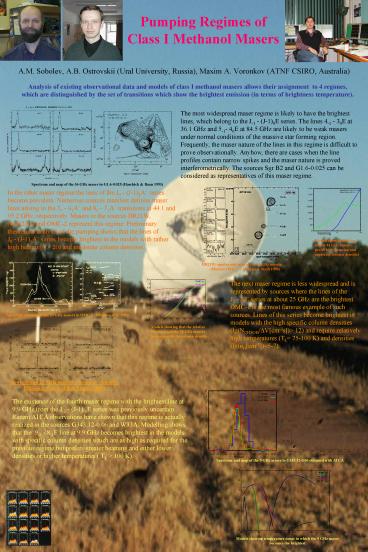Pumping Regimes of Class I Methanol Masers - PowerPoint PPT Presentation
1 / 1
Title:
Pumping Regimes of Class I Methanol Masers
Description:
Pumping Regimes of. Class I Methanol Masers. A.M. Sobolev, A.B. Ostrovskii (Ural ... Preliminary theoretical analysis of the pumping shows that the lines of ... – PowerPoint PPT presentation
Number of Views:43
Avg rating:3.0/5.0
Title: Pumping Regimes of Class I Methanol Masers
1
Pumping Regimes of Class I Methanol Masers
- A.M. Sobolev, A.B. Ostrovskii (Ural University,
Russia), Maxim A. Voronkov (ATNF CSIRO, Australia)
Analysis of existing observational data and
models of class I methanol masers allows their
assignment to 4 regimes, which are distinguished
by the set of transitions which show the
brightest emission (in terms of brightness
temperature).
The most widespread maser regime is likely to
have the brightest lines, which belong to the J-1
- (J-1)0E series. The lines 4-1 - 30E at 36.1 GHz
and 5-1- 40E at 84.5 GHz are likely to be weak
masers under normal conditions of the massive
star forming region. Frequently, the maser nature
of the lines in this regime is difficult to prove
observationally. Anyhow, there are cases when the
line profiles contain narrow spikes and the maser
nature is proved interferometrically. The sources
Sgr B2 and G1.6-0.025 can be considered as
representatives of this maser regime.
Spectrum and map of the 36 GHz maser in
G1.6-0.025 (Haschick Baan 1993)
In the other maser regime the lines of the J0 -
(J-1)1A series become prevalent. Numerous
sources manifest definite maser lines arising in
the 70 - 61A and 80 - 71A transitions at 44.1
and 95.2 GHz, respectively. Masers in the sources
DR21W, NGC2264 and OMC-2 represent this regime.
Preliminary theoretical analysis of the pumping
shows that the lines of J0 - (J-1)1A series
become brightest in the models with rather high
beaming (gt 20) and moderate column densities.
beaming
Models showing that the bright 44 GHz masers
prefer high beaming and moderate column densities
DR21W spectra and map of the 44 GHz masers
(Menten 1991) (Kogan Slysh 1998)
The next maser regime is less widespread and is
represented by sources where the lines of the J2
- J1E series at about 25 GHz are the brightest.
OMC-1 is the most famous example of such sources.
Lines of this series become brightest in models
with the high specific column densities
(lg(NCH3OH/DVcm-3s)gt 12) and require relatively
high temperatures (Tk 75-100 K) and densities
(lg(nHcm-3)5-7).
Spectrum and map of the 25 GHz masers in OMC-1
(Johnston et al. 1992)
Models showing that the relative brightness of
the 25 GHz masers increases with the column
density
Newly found 25 GHz masers (Voronkov, Sobolev,
Ellingsen, Ostrovskii Alakoz 2005)
The existence of the fourth maser regime with the
brightest line at 9.9 GHz from the J-2 - (J-1)-1E
series was previously uncertain. Recent ATCA
observations have shown that this regime is
actually realized in the sources G343.12-0.06 and
W33A. Modelling shows that the 9-2 - 8-1E line
at 9.9 GHz becomes brightest in the models with
specific column densities which are as high as
required for the previous regime but prefers
greater beaming and either lower densities or
higher temperatures ( Tk gt 100 K).
Spectrum and map of the 9 GHz maser in
G343.12-0.06 obtained with ATCA
Models showing temperature range in which the 9
GHz maser becomes the brightest































